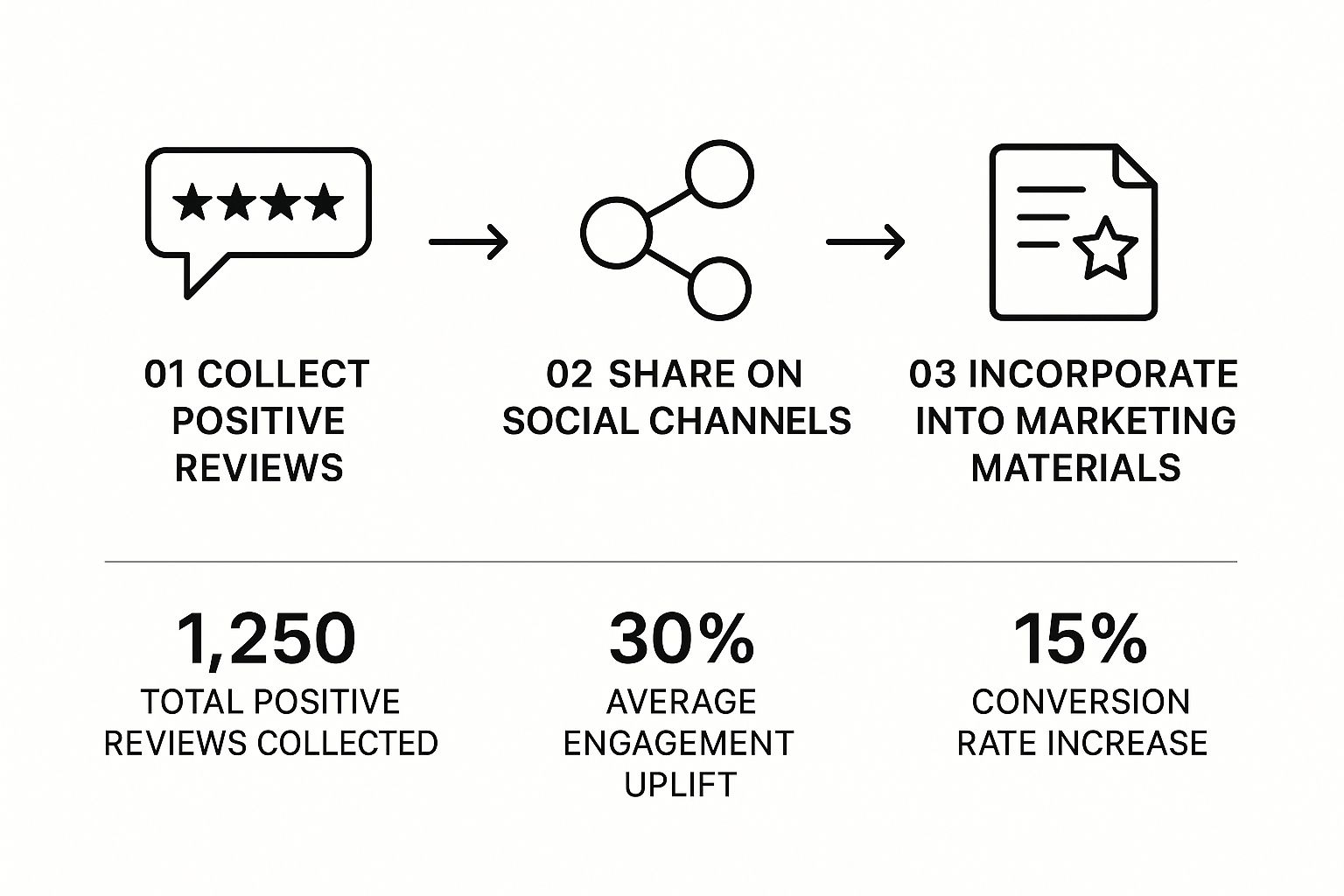Responding to a customer review is more than just good manners—it’s a public conversation that showcases your commitment to customer satisfaction. When you get it right, every single review, whether it's glowing or critical, becomes a powerful marketing tool.
Why Responding to Reviews Is a Growth Engine
Let's reframe how we think about responding to reviews. This isn't just a box to check on your daily to-do list; it's a potent, public-facing growth strategy. Every reply you write is a conversation happening in plain sight of potential customers, and they're all watching to see how you treat people.
This public dialogue is where real trust is forged. When prospects see you actively engaging with feedback, it tells them your business is attentive, transparent, and confident. Suddenly, a static review page transforms into a dynamic showcase of your company's values in action.
The Silent Audience Decides Your Future
Your replies aren't just for the person who left the review. They're for the hundreds, maybe thousands, of future customers doing their homework on your business. These "silent readers" are digging for social proof, and how you handle criticism often speaks volumes more than a dozen five-star ratings.
Honestly, a thoughtful response to a negative review can win over more new business than a simple positive one ever could. It proves you're accountable and committed to making things right, which are massive trust signals for anyone considering a purchase.
When you reply to a guest review, you’re not just responding to the person who wrote the review – you’re writing to all of the potential future guests who’ll be reading it to see how you handle feedback.
The Impact of Responding vs. Ignoring Reviews
The choice to engage or ignore reviews has tangible consequences. One path builds trust and loyalty, while the other can silently erode your brand's credibility. Here’s a quick breakdown of the stakes.
| Action | Potential Positive Outcome | Potential Negative Consequence |
|---|---|---|
| Responding to a Positive Review | Reinforces customer loyalty and encourages repeat business. Shows appreciation and builds a community around your brand. | Missed opportunity to strengthen a customer relationship and show public appreciation. |
| Responding to a Negative Review | Demonstrates accountability and a commitment to resolution. Can turn a negative experience into a positive one and win over new customers. | The negative narrative goes unchallenged, potentially deterring countless future customers. Implies a lack of care or accountability. |
| Ignoring All Reviews | Saves a small amount of time in the short term. | Creates an impression of an unengaged or neglectful business. Your online reputation is left entirely in the hands of others. |
Ultimately, active engagement is a clear investment in your brand's future, turning feedback into a visible asset.
Turning Feedback into Financials
There's a straight line connecting review management to your revenue. Consumer behavior studies show that shoppers read an average of 10 online reviews before they feel they can trust a business. Even more telling, a massive 85% of consumers consider reviews older than three months to be irrelevant. This highlights the urgent need for a steady flow of fresh feedback and your active participation.
This ongoing engagement is what keeps your online presence credible and relevant. A well-managed review profile directly boosts your search engine rankings and, in turn, your bottom line. Building this public trust is a huge piece of why your online reputation is important for long-term growth.
When you learn how to automate processes for real business growth, it's not just about saving time. A streamlined system ensures you never miss a chance to respond, build trust, and drive revenue.
Turning Positive Reviews Into Marketing Assets
A glowing review is so much more than a pat on the back. It's a powerful piece of marketing content just waiting to be used. When you respond thoughtfully, you're not just thanking one person; you're showing every potential customer who reads it exactly what makes your business special. This is your moment to transform a happy customer into a genuine brand advocate.
The trick is to go beyond a generic "Thanks!" Your reply needs to feel personal while also providing real value to anyone else reading it. By doing this, you highlight the specific things people love about your business, building a strong case for why new customers should choose you.
Personalize Your Appreciation
First things first: personalization is everything. Canned, copy-paste responses are a huge turn-off. You need to show that you actually read and absorbed what they said by referencing specific details from their review. This one small step makes a customer feel truly heard and appreciated.
Let's say a customer at your coffee shop raves about the "amazing oat milk latte and friendly barista, Sarah." Your response should absolutely mention Sarah by name and their specific drink. This instantly turns a standard thank-you into a meaningful, human connection.
A personalized response does more than just thank the reviewer; it publicly reinforces the exact elements of your business that create positive experiences, guiding future customers toward your key strengths.
That kind of detail proves you're paying close attention and are genuinely invested in the customer experience.
Weave in Keywords and Unique Selling Points
Think of your response as a mini-opportunity for some savvy marketing and SEO. As you're writing, look for natural ways to include keywords related to your services, products, or location. It's a simple but incredibly effective way to give your local search visibility a little boost.
Here's how that looks in the real world:
- Original Review: "Loved the deep tissue massage I got here last week. Best I've had in a while!"
- Strategic Response: "We're so glad you enjoyed your deep tissue massage! Our therapists in our downtown Seattle studio work hard to provide the best experience. We hope to see you again soon!"
See what happened there? The reply echoes the specific service ("deep tissue massage") and drops in a location keyword ("downtown Seattle"). It feels completely natural, but it provides powerful context for both search engines and potential customers browsing reviews.
This tactic subtly markets your business right inside the review thread, turning a single positive comment into a discovery tool. Every single reply becomes another small piece of your online marketing puzzle, which is why knowing how to respond to reviews is such a critical skill. This isn't just about being polite—it's smart business.
How to Navigate Negative Reviews and Win Back Trust
Let’s be honest, a negative review stings. It can feel like a personal attack. But if you can get past that initial gut reaction, you’ll see it for what it really is: a chance to show everyone what your business is made of.
How you handle criticism in a public forum says more about you than a hundred 5-star reviews ever could. The goal isn’t to win an argument—it’s to make a frustrated customer feel heard. That single act can not only save the relationship with them but also shows every other potential customer reading the reviews that you’re a business that solves problems with integrity.
The Acknowledge, Apologize, and Act Framework
After years of managing reputations, I’ve found that the best responses all follow a simple, yet powerful, three-part structure. It sidesteps excuses and puts the focus squarely on the customer’s experience and your desire to fix it. This isn't just damage control; it's trust-building 101.
- Acknowledge Their Frustration: First, just validate what they’re saying. A simple, "I'm so sorry your experience didn't live up to expectations," or "Thank you for bringing this to our attention," immediately de-escalates the situation. It shows you're listening, not just waiting to defend yourself.
- Offer a Real Apology: Apologize for the specific thing that went wrong. This isn't about admitting legal fault; it's about showing empathy and regret that their experience wasn't great.
- Act by Taking it Offline: The public review section is for acknowledging the issue, not for a back-and-forth debate. Your final step should always be to provide a direct line for resolution. Offer a manager's name, a specific email address, or a direct phone number.
This approach stops a public argument before it starts and makes you look like a pro. For a deeper dive, our complete guide on responding to negative reviews has a ton of specific examples.
Why You Need to Reply—Fast
When a bad review pops up, the clock starts ticking. Speed is your secret weapon. Think about it: research shows that a staggering 95% of unhappy customers will give you another shot if you resolve their complaint quickly.
You're also meeting a very real expectation. Around 53% of customers expect a business to respond to their review within a week. A fast reply shows you're paying attention and that you actually care, which can cool down a heated situation instantly.
Responding to a negative review isn't just about fixing one person's problem. It's a public performance of your company's character. Every potential customer is watching to see how you handle things when they go wrong.
Crafting a Response That Protects Your Brand
The language you use is critical. You have to take ownership of the customer's experience without making broad admissions of fault that could come back to bite you. The goal is empathy, not a public confession.
Let's walk through a real-world scenario.
Imagine a restaurant gets a 1-star review about painfully slow service on a busy Saturday night.
- A Bad, Defensive Response: "We were slammed and understaffed on Saturday. Our team was doing the best they could. You weren't the only ones waiting."
- A Great, Effective Response: "We're so sorry to hear the service was slower than usual during your visit. We know how frustrating a long wait can be, and we appreciate you letting us know. Could you please reach out to our manager, David, at [email]? He'd appreciate the chance to learn more and make this right for you."
See the difference? The second one acknowledges their specific frustration, offers a sincere apology, and moves the problem-solving offline. No excuses, just a solution. That’s how you turn a bad review into a net positive for your reputation.
Finding the Opportunity in 3-Star Reviews
While 5-star raves feel great and 1-star rants demand immediate attention, the real gold is often found right in the middle. I've always seen the 3-star review as a goldmine of honest, unfiltered feedback that can point directly to meaningful business improvements.
These customers aren't furious; they're just… ambivalent. They saw the potential in your business but also hit a snag somewhere along the way. Learning how to handle these reviews is a special skill. It’s your chance to turn a lukewarm customer into a loyal advocate simply by showing you care about getting better.
Acknowledge the Good and the Bad
The secret to handling a mixed review is to tackle both sides of it head-on. You absolutely have to start by thanking them for their business and for taking the time to share their detailed thoughts. It shows you appreciate their honesty right from the get-go.
Next, make a point to mention the specific positive things they brought up. This validates their good experience and reinforces what you're doing right. From there, you can pivot to the criticism with sincerity.
- Example Phrasing: "Thanks so much for visiting us and for your honest feedback! We're thrilled you enjoyed our new patio seating. We’re also sorry to hear that the wait time for your main course was longer than expected."
This balanced approach proves you actually read the entire review and value their whole experience—not just the flattering parts.
A 3-star review is a conversation starter. The customer is telling you, "I want to love your business, but this one thing is holding me back." Your response is your chance to finish that conversation.
Treat Criticism as Constructive Input
Whatever you do, don't get defensive. The best move is to frame their criticism as helpful advice. This immediately shifts the dynamic from a complaint into a collaboration. Your public response becomes a testament to your commitment to excellence, and you can bet future customers will notice.
This is also a great time to ask clarifying questions, if it makes sense. Showing you want to understand the issue in more detail is a huge trust signal. It proves you're not just giving a canned response but are actively looking for ways to make sure it doesn't happen again.
Offer a Path to Resolution
Just like with negative reviews, you need to provide a clear next step. Invite the customer to take the conversation offline to discuss their experience further. This shows you're taking their feedback to heart and gives you a chance to forge a more personal connection.
Don't just be vague about it.
- Good: "We'd love to learn more about your experience."
- Better: "Our manager, Jessica, would appreciate the chance to connect with you directly. Could you please email her at [email] so she can follow up?"
That specific, action-oriented closing shows you have a real process for handling feedback. It turns a moment of mixed feelings into a powerful display of your dedication to customer satisfaction—and that's a massive win for your reputation.
Building a Scalable Review Response Workflow
When you're first starting, responding to every single review feels like a mountain to climb. As your business scales, it can quickly become that overwhelming task that gets shoved to the bottom of the to-do list. The secret isn't to work harder; it's to build a smart, scalable workflow that keeps your responses consistent without burning you or your team out.
A solid system takes the guesswork out of the daily grind. It gives your team the power to handle feedback efficiently, turning what feels like a reactive chore into a proactive strategy for building a stellar reputation. This is how you keep that personal touch, even as you grow.
Establish Your Response Guidelines
Before you even think about writing a reply, you need a playbook. Your response guidelines are the foundation of your entire workflow, making sure every comment that goes public aligns perfectly with your brand’s voice and values. Think of this document as your team's single source of truth for handling customer feedback.
To really nail down consistency, it’s worth taking the time to learn how to write a Standard Operating Procedure. This formalizes your process, making it simple for anyone on your team to jump in and respond the right way, every time.
Here’s what your guidelines absolutely need to cover:
- Tone of Voice: Are you conversational and friendly, or more buttoned-up and professional? Define it. Get specific.
- Response Time Goals: Set realistic targets. A great starting point is aiming to reply within 24 hours for negative reviews and within 48-72 hours for positive ones.
- Key Responsibilities: Who owns this process? Designate one main person and a backup. This simple step ensures nothing ever falls through the cracks.
Create Smart, Flexible Templates
Templates often get a bad rap, but for efficiency, they’re a must. The trick is to treat them as a starting point—a launchpad, not a copy-and-paste final answer. A good template gives you the core structure, but it’s your team that adds the personal details that make a response feel truly genuine.
A great template saves you from reinventing the wheel. It should handle about 80% of the response, leaving that critical 20% for personalization that speaks directly to that customer's unique experience.
For instance, a template for a glowing review might have placeholders for the customer's name, the specific product they loved, and a unique closing line. This keeps the core message on-brand while pushing your team to add that human touch.
Centralize and Consolidate Your Reviews
Constantly bouncing between Google, Yelp, Facebook, and a dozen other platforms is a huge time-waster. A workflow that can actually scale has to bring all those reviews into one central, manageable hub. This is where the right tools become a total game-changer.
Seriously, the right platform can completely transform your process. Investing in top-tier customer feedback management software lets you monitor and reply to reviews from a single dashboard. That consolidation alone will save you hours and prevent reviews from getting lost in the shuffle.
This infographic shows just how powerful centralizing your feedback can be for turning positive comments into marketing gold.
As you can see, a streamlined system for gathering and sharing feedback has a direct impact on engagement and sales. It's wild, but responding to reviews can boost conversion rates by up to 80%. Yet, a whopping 42% of companies don't reply to all of them, simply because they don't have a good workflow in place. An efficient system isn't just nice to have; it's crucial for growth.
Answering Your Toughest Review Response Questions
As you start getting more intentional about responding to reviews, you're bound to run into some tricky situations. It's one thing to know the basics, but it's another to handle those weird, one-off scenarios that pop up. Let's walk through a few of the questions I hear most often from business owners.
Do I Really Need to Respond to Every Single Review?
Look, in a perfect world, you'd respond to every review. But we don't live in a perfect world, and you're busy. So, let's get practical and prioritize.
Your absolute, non-negotiable priority is to respond to 100% of your negative and neutral reviews. These are the comments that can actively turn potential customers away, so they need immediate attention.
When it comes to the happy customers, try to reply to as many as you can. I always tell clients to give a little extra love to the positive reviews that are super detailed or tell a great story about their experience. A thoughtful approach shows you’re truly engaged, which is way better than just responding randomly here and there.
Think of every response as a mini-advertisement for your customer service. Even a quick "Thanks so much!" on a 5-star review tells future customers you're paying attention.
What’s the Best Way to Handle a Fake or Unfair Review?
This is a frustrating one, and the temptation to fight back is real. But trust me on this: never get into a public shouting match. You will not win, and you'll just end up looking unprofessional to everyone else reading the exchange.
Your first step is always to flag the review through the platform's official channels. Most platforms like Google and Yelp have a process for reporting reviews that violate their terms of service.
While that's under review, you can post one—and only one—calm, professional public reply. The goal here isn't to argue with the person; it's to show other potential customers how you handle difficult situations.
- Here's a solid example: "We take customer feedback very seriously, but we've searched our records and can't find anyone matching your name or the situation you've described. We'd love to look into this, so please contact our manager directly with your order details."
This response shows you're proactive without getting dragged into the mud.
How Fast Do I Need to Be with My Responses?
When it comes to reviews, speed matters. A lot. Especially for the negative ones.
You should make it a goal to respond to all negative feedback within 24 hours. When a customer is upset, a quick reply is the first step in de-escalating the situation and showing them you genuinely care about fixing the problem.
For positive reviews, responding within a day or two is great. It reinforces that good feeling they have about your business while the experience is still top of mind. The easiest way to make this happen is to turn on notifications for new reviews. A simple email or app alert lets you stay on top of the conversation, making your strategy for how to respond to reviews proactive, not just reactive.
Ready to stop chasing reviews and start managing your reputation with confidence? Reviews To The Top brings all your feedback into one place, makes responding a breeze, and helps you stand out in search results. Discover how our platform can help you build trust and attract more customers today!





